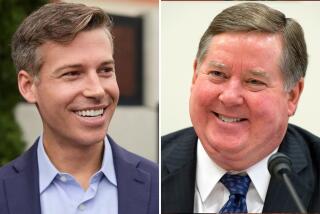CALIFORNIA ELECTIONS : 4TH CONGRESSIONAL DISTRICT : Close Battle That Sums Up a Quirky Year
The Mother Lode country of Northern California, where the 4th Congressional District cuts a huge swath from South Lake Tahoe to Sacramento and through Placer and Mono counties, has become a political battleground that captures all the quirks of the 1992 election year.
John T. Doolittle, one of the staunchest House conservatives, is running against Patricia Malberg, a maverick Democrat waging a Perot-style campaign in a contest that is too close to call.
Political experts, who cite the Republican advantage in registration numbers--46% to 43%--say this should have been a slam-dunk for the GOP. Malberg, a former community college teacher, came within 2 points of beating Doolittle in 1990, but a repetition of that impressive showing had seemed unlikely this year because redistricting added more GOP terrain.
Now the experts are hedging their bets.
“I have this one on my ‘weird upsets list,’ ” said political analyst Bruce Cain, who says the numbers still favor sending Doolittle back to the House, but believes that other, potentially more powerful forces could tip the race in Malberg’s favor.
The gold, after all, is long gone from the area’s famous Sutter’s Mill, and the sagging state economy, plus the strong anti-incumbent tide in this Year of the Woman, may defy conventional election mathematics.
Doolittle, who led the Republican caucus in the state Senate, made his mark as a conservative activist, riding social issues that dominated the right-wing agenda in the 1980s. He pushed mandatory AIDS testing, restrictions on abortion, strict enforcement of the death penalty and new laws against burning the flag.
This year, as in 1990, he expected to paint Malberg as a tax-and-spend liberal whose policy prescriptions mirror those of the Democratic majority in Congress. But her folksy brand of populism and oddly cheerful anti-Establishment message has not lent itself to that line of attack.
Democratic Party officials, although more than eager to unseat Doolittle, considered Malberg a lost cause and were slow to come to her aid. They took a second look after Don Brooksher, Doolittle’s moderate GOP primary opponent, decided to mount a write-in challenge in the general election and raised the specter of a split Republican vote.
Brooksher, who polled a surprising 29% of the vote in the primary, said he mounted a write-in campaign solely to push a thorn in Doolittle’s side.
Doolittle made the kind of splash in Congress that most first-termers only dream about. As a member of the “Gang of Seven” Republican freshmen who brought the House banking and post office scandals to front pages across the country, he was a rising star in the House GOP’s boisterous right wing. Elected to Congress after three terms in the state Senate, he outmaneuvered more moderate senior members of the state’s Republican delegation to become point man for the GOP on congressional redistricting.
But after years of polishing a career as the most ardent of conservative ideologues, Doolittle, 41, seems to have discovered belatedly that he is in a race where labels such as liberal and conservative are almost irrelevant.
“Doolittle was caught off guard and things have changed dramatically this year,” said campaign spokesman Bill Mueller.
Mueller was helping college Republicans assemble packets in Doolittle’s cavernous headquarters off Interstate 80 in Rocklin, just north of Sacramento. The students were part of a “Neighbor to Neighbor” campaign Doolittle began in October to mobilize 1,800 volunteers across the eight-county district. Malberg’s volunteers had been in the field since June.
Doolittle’s troubles began just after the June primary when a National Taxpayers Union survey found that he sent more mail at taxpayers’ expense during the first quarter of 1992 than any other congressman. The label “No. 1 Franker” has stuck, despite Doolittle forces’ best efforts to portray his heavy mailing budget as a clever way to deny Democratic leaders the use of unspent franking money for their nefarious purposes.
Malberg, 51, made her first bid for Congress in 1988, managing to pull 38% of the vote in an area where Democrats had never broken the 25% mark.
“She’s got a helluva organization--it’s the real thing,” said Democratic consultant Richie Ross, a friend who is serving as an unpaid adviser to the campaign. “She’s uncommonly decent and people believe in her.”
Indeed, Malberg’s supporters are more apt to cite her personality than her policies as the reason she should be elected. Nonetheless, they are committed to her general theme of change.
“I’ve never been involved in a political campaign,” said Cynthia Spears, a lifelong Republican who volunteers full time as a bookkeeper in Malberg’s Lincoln campaign office. “I’ve never been attracted to politics. The whole idea really disgusts me. But it was very easy to step into her campaign.”
Malberg’s unconventional campaign--no manager, no consultant and an all-volunteer staff--has been her greatest strength and biggest weakness. Although some national women’s groups were quick to offer support, EMILY’s List, the Washington-based fund-raising organization for Democratic women, initially withheld an endorsement. It finally came in August and generated about $35,000 on Malberg’s behalf.
The Democratic Congressional Campaign Committee, likewise skeptical about Malberg’s viability and organizational know-how, recently contributed $5,000.
Malberg’s populist credentials notwithstanding, much of her money has come from PACs, among them the California Teachers Assn., the United Auto Workers, the National Education Assn. and the American Nurses Assn. As of last week, Malberg had raised $246,476, compared to $445,573 for Doolittle.
More to Read
Get the L.A. Times Politics newsletter
Deeply reported insights into legislation, politics and policy from Sacramento, Washington and beyond. In your inbox three times per week.
You may occasionally receive promotional content from the Los Angeles Times.










